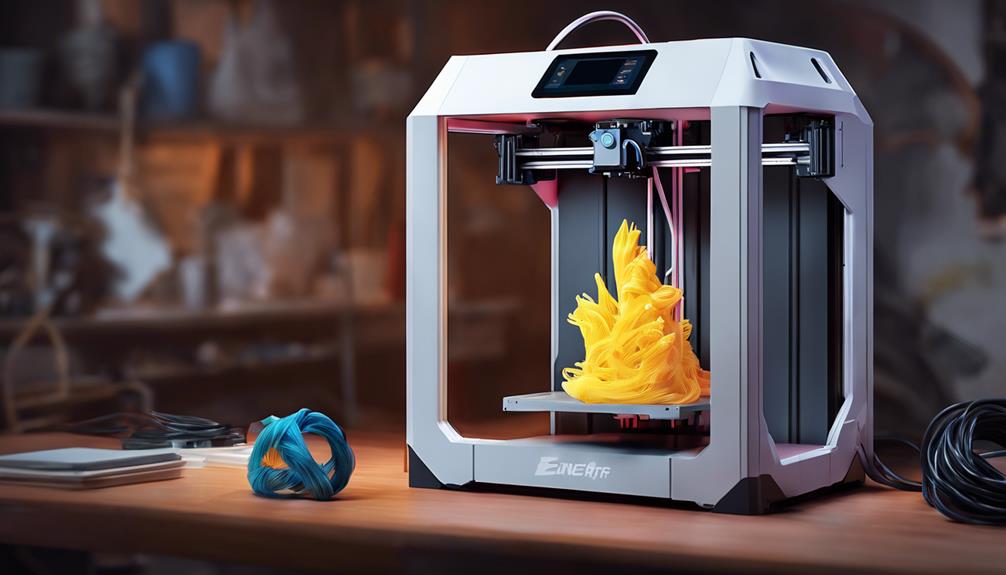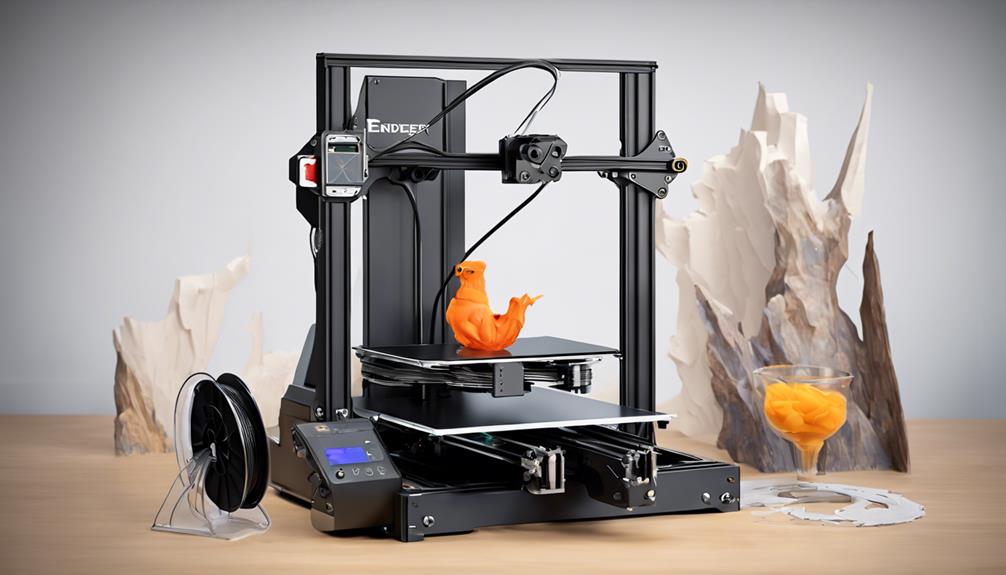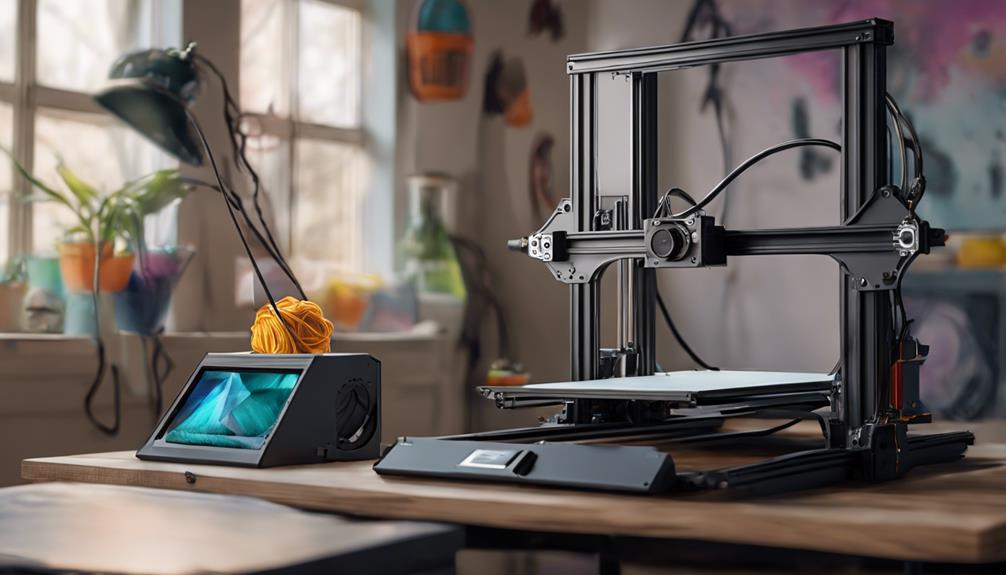To master filament swaps effectively on your Ender 3, understanding expert tips is key. Imagine effortlessly shifting between different filaments without the hassle of clogs or disruptions. What if you could guarantee each swap is seamless, maintaining the quality and consistency of your prints? By following specific techniques and steps meticulously, you could elevate your 3D printing experience to a whole new level.
Proper Preheating for Filament Swaps

When getting ready to swap filaments on your Ender 3, make sure you heat the nozzle to the new filament's printing temperature for best results. This step is important to guarantee the smooth shift between filaments and prevent issues like clogging.
By reaching the correct temperature, the old filament will melt away more cleanly, making it easier to unload. Heating the nozzle to the new filament's printing temperature also aids in preparing the extruder for the characteristics of the incoming material.
Correct Filament Unloading Techniques
To guarantee a smooth filament unloading process on your Ender 3, follow these essential steps for best results.
Access the printer menu and set the proper nozzle temperature. Wait for the filament to melt before removing it. Press down on the idler arm to unload the filament effectively.
Heat the nozzle to the new filament's printing temperature for loading. Cut the filament sharply and guide it into the extruder. Push the filament through the tube until it reaches the nozzle.
Essential Steps for Loading New Filament

When loading new filament into your Ender 3 printer, make sure you cut the filament sharply and guide it into the extruder for successful printing. Heat the nozzle to the new filament's printing temperature before inserting the filament.
Once the nozzle is ready, cut the end of the filament at a sharp angle to guarantee a clean entry into the extruder. Gently guide the filament into the extruder gear while applying slight pressure to help it grip.
Continue pushing the filament until it reaches the hot end and extrudes smoothly. Proper loading guarantees a consistent flow of filament during printing, reducing the chances of jams and improving print quality.
Thorough Cleaning of the Nozzle
After confirming successful filament loading, maintain peak printing performance by thoroughly cleaning the nozzle to prevent clogs and guarantee consistent extrusion.
To clean the nozzle effectively, heat it up to the printing temperature and carefully remove any leftover filament residue using a nozzle cleaning needle or filament cleaner. Inspect the nozzle for any stubborn particles and use a soft brass brush or a cold pull method to clear any remaining debris.
Make sure the nozzle is completely clean before starting your next print to avoid blockages and printing issues. Regularly cleaning the nozzle after filament changes will help sustain the quality of your prints and prolong the life of your Ender 3 printer.
Bed Leveling Post Filament Change

Consider re-leveling your bed after changing filament to guarantee the best printing conditions for your Ender 3. Ensuring proper bed leveling is essential for successful prints, especially when dealing with different filament types that might require adjustments due to temperature variations. Below is a simple guide to help you maintain excellent bed leveling post-filament change:
| Bed Leveling Steps | Description | Importance |
|---|---|---|
| Check Bed Screws | Ensure all screws are tight | Prevents bed wobbling |
| Adjust Corner Screws | Fine-tune each corner level | Ensures even first layer |
| Verify Bed Adhesion | Test bed adhesion with paper | Proper first layer adhesion |
| Run Bed Leveling Test | Confirm leveling accuracy | Ensures overall bed level |
Following these steps will help maintain consistent print quality after changing filament.
Frequently Asked Questions
Can I Leave the Old Filament in the Nozzle During a Filament Swap?
You should not leave the old filament in the nozzle during a filament swap. Properly unload the old filament to prevent clogging. Make sure to check that the nozzle is clear before starting a new print for successful results.
Is It Necessary to Cut the Filament at a Specific Angle for Loading?
When loading filament, it's important to cut it at a sharp angle for smooth insertion into the extruder. This sharp cut helps guide the filament into the tube and prevents any potential snags or misfeeds during the process.
How Can I Ensure Complete Removal of Old Filament Residue From the Nozzle?
To guarantee complete removal of old filament residue from the nozzle, heat it to melting point, then manually push through the idler arm. Confirm no traces are left. Remember, cleanliness is key for successful prints.
Should I Re-Level the Bed After Every Filament Change, Regardless of Type?
After changing filament on your Ender 3, re-level the bed may be needed for different types due to temperature variations. For same filament types like PLA, re-leveling might not be necessary, but check bed leveling guides for specifics.
Is It Okay to Manually Push the Filament Into the Nozzle Without Preheating?
Sure, you could play a risky game and manually shove filament into a cold nozzle, but beware the wrath of clogs and failed prints. Preheat that nozzle, mate, and save yourself the hassle.
Conclusion
Now that you've mastered filament swaps on your Ender 3, you're ready to tackle any printing project with ease.
Remember, just like changing colors in a painting, smooth shifts in 3D printing can truly elevate your creations.
Keep honing your skills and exploring new possibilities – the world of 3D printing is yours to conquer!